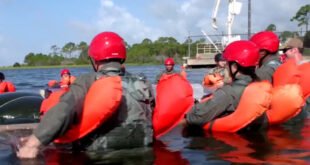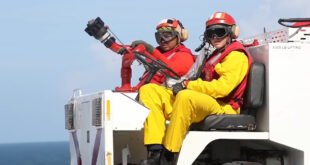In this video, discover the amazing US technique used to extract special forces in the middle of the sea. Watch as the US military showcases their advanced marine extraction capabilities, showing why they are the best in the world!
A land-based fighting force finds few things more horrifying than the sight of an approaching amphibious assault, especially one coming from the US military. The United States has become one of the most powerful water-to-land strike forces in the world since World War II.
Today’s activities are far more complicated, frequently requiring many people, vehicles, and pieces of equipment. For example, the U.S. Navy’s ability to maintain dominance around the globe is based mostly on its aircraft carriers. The United States can conduct air operations all over the world because of their use as movable airbases.
Combat Rubber Raiding Crafts, or CRRCs, and patrol boats can be employed for smaller operations to swiftly get troops from ship to shore. Because of Navy SEALs and other Special Operations commonly employ their low profile, which makes them perfect for stealth missions, forces for covert operations, including reconnaissance, direct action, and personal recovery.
Also known as Zodiac Boats or Rubber Raiding Crafts, CRRCs are generally lightweight, inflatable boats. Depending on the mission, these boats are prized for their versatility and can accommodate between six to eight fully equipped soldiers. However, for short distances and in emergency situations, they can carry more.
Though CRRCs come in a variety of sizes, the ones that the US military uses the most are usually between 15 and 17 feet long. The dimensions provide a suitable equilibrium between load capacity and capability and maintain a low profile and agility. Because of their inflatable construction, users typically swap out outboard motors for power in CRRCs.
This implies that the engine type installed can change based on the particular needs of the operation, such as a desire for stealth, speed, or range. U.S. soldiers usually practice with their CRRCs on a regular basis so that they are prepared to handle nearly any circumstance with confidence. In order to enhance their own and their allies’ safety, they must learn how to inflate the boat properly, operate it, and make use of the equipment that comes with it.
The portability of CRRCs is one of their major benefits. Users can swiftly deploy CRRCs from a variety of platforms and store them compactly. An empty boat usually weighs about 550 pounds, even with an engine mounted, so a team can readily lift and move it.
When it comes to turning the ship, this is also quite important. This method entails intentionally capsizing the boat using pulleys and people serving as counterweights. This can help with everything from handling choppy water conditions to avoiding discovery.
More so than aircraft carriers, amphibious transport docks are vital to many sea-to-land operations. Well decks, which are open spaces at sea level on these big ships, include ramps that make it simple to deploy and retrieve amphibious vehicles. Boats can drive in and out through flooded decks.
Underwater construction workers and divers who dispose of explosive ordnance also employ CRRCs because of their versatility. This is mostly due to the fact that the CRRCs’ incredibly light design enables them to function in situations where other boats may be in danger of damage, in shallow waters or close to rugged shores. During diving operations, personnel can position themselves directly above the target location, allowing for quick and simple access to whatever is below them.
Having stated that helo casting operations may employ CRRCs in one of their most significant applications,. Helo casting is one of the most significant and hazardous tasks of all, with very little margin for error. Helo casting is typically used for the quick deployment of special operations soldiers.
Helocasting takes intense training because it includes jumping into the sea from a moving airplane. Since the majority of soldiers will be making the jump fully armed and equipped, it is imperative that they are aware of what to expect. Soldiers usually complete this training at a facility with a large pool.
Candidates need to be able to swim well and feel at ease in a variety of aquatic settings. Technically speaking, we categorize helo casting as Special Patrol Insertion and Extraction, or SPI, operations. A sturdy rope that is fastened to a hard point on the helicopter’s underbelly is part of the SPI rigging system.
This rope descends to a set of loops or harnesses that serve as secure fastening points for soldiers. The crew straps in and gets ready, and then the helicopter takes off, carrying them beneath it.
When it is not safe for a helicopter to land and help people in need, they can use a harness, cage, or even a single rescuer to help the people who are in danger escape. This is especially useful in situations where a helicopter cannot land, like in maritime rescues. The capacity of helicopters to hover and move vertically makes them indispensable for a variety of military and non-military tasks.
Vertical replenishment, or VRTREP, is one of the specialized functions of helicopters and is essential for logistical assistance.
The military can even move armored vehicles like Humvees and heavy weapons with some of its larger helicopters. A typical unarmored Humvee weighs between 5,200 and 5,900 pounds at the curb. Nevertheless, the weight can rise significantly with armor and other combat-ready setups; some armored models weigh more than 8,000 pounds.
Helicopter pilots will need to connect tow lines to the vehicles and fly low over the terrain in order to get these vital vehicles where they needed to go. This is just one more instance of how the US military uses powerful planes to complete logistical missions that would otherwise be unfeasible. The video ends at that point.
I hope it was enjoyable for you. To ensure that you don’t miss any of our upcoming content, please subscribe to this channel. Until we meet again. View more Extract Special Forces posts
 DailyDiscovery
DailyDiscovery





